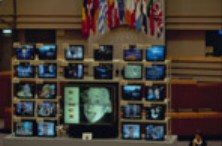
The European Integration |
The Origins of European Integration | A-D E-H I-Z |
| EU Institutions | ||
| The Decision Making Process | ||
| EU Policies: from A to Z | ||
| The EU in the World | ||
Audiovisual Policy
The audiovisual industry (film and television) is a sector whose economic importance has grown
over the years and which has very great sociological and cultural implications.
However, up until the 1980s, the European Community activity in this sector was
no more than marginal. In the beginning of the 1980s, the development of new broadcasting and distribution techniques and the realisation that the European Community was falling behind the United States in the programme-making sector, especially where television programmes were concerned, prompted the Community institutions to take new initiatives (link below) with technological, economic and cultural aspects. MEDIA programmes: "Measures to Encourage the Development of the Audiovisual Industry": The "Media" programmes form the second strand of the audiovisual policy after the "TV without frontiers" Directive. These programmes provide support schemes for the European film and television programme industry with the aim of making this industry more competitive and more capable of meeting the needs of an ever increasing number of television stations. Initiatives in the broadcasting sectorIn 1984, the Commission presented a Green Paper on the establishment of a common market in broadcasting. On 22 June 1984, the Council adopted resolutions concerning the development of a European programme-making industry, measures to combat audiovisual piracy and the harmonisation of the rules on the distribution of film by the various media. In its 1985 White Paper on the completion of the single market, the Commission gave notice of several initiatives intended to open up the audiovisual market to competition in the Member States and promote high-definition television. It was in 1986, with the proposal for a Council Directive on television broadcasting, that reference began to be made to a "Community audiovisual policy". In 1988-1989, the Commission promised legislative measures to establish the conditions in which a European film and television industry could prosper. The European Year of Cinema and Television (1988) afforded an opportunity for in-depth discussions with the national authorities and the audiovisual industry on possible measures in this field. One of the innovations of the Maastricht Treaty, which entered into force on 1 November 1993, was the inclusion of a specific reference to the audiovisual sector in Article 128 of the Treaty establishing the European Community, which deals with culture: "Action by the Community shall be aimed at encouraging cooperation between Member States and, if necessary, supporting and supplementing their action" in such fields as "artistic and literary creation, including in the audiovisual sector". The Protocol on the System of Public Broadcasting annexed to the Treaty of Amsterdam (1999) confirmed the importance attached by the Member States to the role of public broadcasting, which is linked to the democratic, social and cultural needs of each society as well as to the need to safeguard plurality in the mass media. | ||